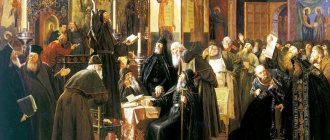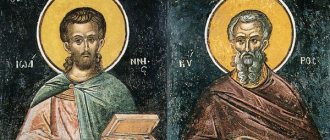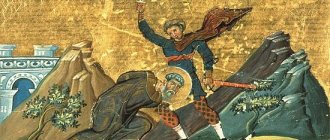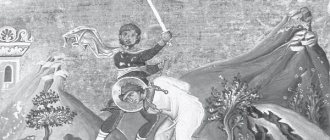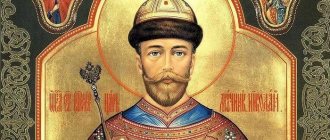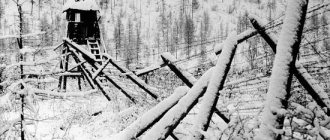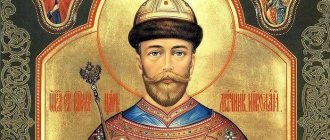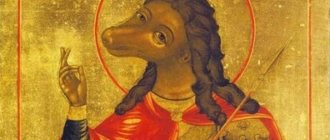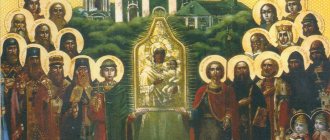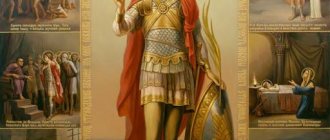Was the betrayal of Judas a necessary link in the work of the Redemption of man?
Nowadays, we often have to deal with prejudice regarding the role of Judas in Divine Providence. According to a number of thinkers, if he had not betrayed the Savior, He would not have been captured and crucified, which means there would have been no Redemptive Sacrifice on the Cross, there would have been no forgiveness of sins and salvation. In a more cautious version, this philosophical idea is replaced by another: if Judas refused to betray, his role would certainly have to be filled by someone else, for this was God’s plan of Redemption.
In line with such concepts, the moral assessment of Judas varies.
According to one version, he was not motivated by a thirst for profit (thirty pieces of silver is the price of a slave), but by the desire for the speedy manifestation of the Divine glory of Christ. Within the framework of this judgment, Judas allegedly believed that when the Lord becomes the prey of his enemies, then he will certainly manifest and publicly reveal the hidden power of His Divinity, which will cause universal recognition of His Divinity, obedience, and salvation.
An even more original statement says that Judas, having sold Christ, did not actually betray Him, but performed a feat of humility and self-abasement, as if he, having fulfilled the task of the traitor, carried out the Lord’s order, which served to realize God’s plan, which included taking Christ into custody, interrogation, the Suffering of the Cross, death. Therefore, being scolded for betrayal, he will be scolded undeservedly. Therefore, the commentary on this story should be rewritten, because in the sight of God, Judas is a great saint.
What can you say to this? The opinion that Judas Iscariot is not a traitor is bad. Following this free interpretation, it is easy to come to the conclusion that some merit in the matter of Salvation also belongs to the murderers of Christ. After all, it is possible (but not necessary) to say about them: if it were not for the murderers, there would have been no Death on the Cross, there would have been no victory over hell and the Resurrection.
But this is not so. And the point here is this. Unlike people, the details of the earthly ministry of the Son of God were known to Him even before the creation of the world. He knew from eternity that many Jews, due to hardness of heart and recklessness, would not accept His Gospel, and from eternity He knew that one of His disciples, flattered by profit, would not persist in piety. If the events of those times, for some reason, were destined to develop differently, this would affect individual details of the plan of Salvation, but not the plan as a whole. The rescue would still have taken place.
The villainy of Judas is directly captured by the words of the Gospel, testifying that he committed the betrayal not out of spiritual simplicity and, especially, not out of the secret blessing of God, but consciously, according to the inspiration of Satan (Luke 22:3). In addition, the Savior personally called him the devil (while the instigators of His murder were called “only” the children of Satan in John 8:44, John 6:70).
***
Archpriest Dimitry Yurevich, Head of the Department of Biblical Studies of the St. Petersburg Theological Academy
Who is he
To tell a long story briefly, they most often say: “Judas was one of the twelve disciples -
apostles of Jesus Christ, thereby betraying his teacher for 30 pieces of silver.
Having committed such a heinous act, he committed suicide, having first returned the money paid for the betrayal to the high priests.” This interpretation is often given by Wikipedia, as well as a number of other sources that allow you to quickly familiarize yourself with the essence of what is happening.
But the more interesting question is: who was this character before, from the moment of birth to suicide? Why did you decide to betray your own mentor? Where is the logic in actions?
The Bible is very stingy in describing the life path of this person, his deeds and thoughts. Scripture gives answers only to the simplest questions: “Who is this – Judas Iscariot?”, “What did he do?”, “How did he die?” The remaining versions are the work of historians, archaeologists and researchers in the field of antiquity. All of them are equally truthful and thought out, since, alas, probably no one will be able to get to the bottom of the truth.
Based on lengthy searches, it became reliably known that this apostle had good spiritual qualities, was very smart and savvy. But the mystery remains of that very act, which does not fit either into the framework of the Christian worldview or into logical considerations.
What was Judas' role in all this? Without him it was impossible to make an arrest?
The role was key. Judas’ betrayal was not limited to the fact that on Wednesday he came to the high priests, reported some information and received thirty pieces of silver for it. No, for this money more was required of him: he had to lead the entire “special operation”. That is, firstly, to bring the temple guards and Roman soldiers to the right place at the right time, and secondly, to show who exactly should be arrested, which of those gathered on the Mount of Olives is Jesus. For the Roman soldiers, all these Jews were alike; they had to give a sign who to grab. Thirdly, Judas should have “settled” problems if they suddenly arose.
And problems did arise. From the Gospel of John the Theologian we know an important detail that other evangelists do not have. When this armed crowd approaches, Christ, knowing the intentions of their hearts, asks: “Whom are you looking for?” They answer: “Jesus of Nazareth.” He replies: “It’s me!” And then everyone falls on their faces. Everyone, including Roman soldiers.
Why are they falling? There is a version that the words of Jesus, translated as “I am” in the Greek translation, sounded like the name of God in Hebrew. That is, “Yahweh.” This name in that era should no longer be pronounced out loud, and when they heard it, the Jews fell on their faces in fear. But why then did the Romans fall, for whom all this meant nothing? Commenting on this place, St. John Chrysostom suggests that at the moment when the Lord revealed himself, something happened, somehow He revealed His power. Even the Roman soldiers were affected, confusion and confusion arose. And then Judas, in order to stop possible panic, decisively intervenes and comes to the fore. He greets Jesus - both to show the soldiers who to grab, and to reassure them: they say, everything is in order, everything is under control, this is an ordinary person, since I greet him in such a friendly way.
Examples
Lenin Vladimir Ilyich (1870 – 1924)
In the article “On the color of shame in Judushka Trotsky,” Ilyich calls Trotsky as Judushka Trotsky.
Repin Ilya Efimovich (1844 – 1930)
“Far and Close” (Youth 1859-1861. III Nikulin):
“Nikylin was handsome, dignified, and even kiss as legal.”
Dostoevsky Fyodor Mikhailovich (1821 – 1881)
“Humiliated and insulted” - Masloboev says about the prince:
“But the main thing is: beware of this prince. This is Judas the traitor
and even worse."
Masloboev says about one man:
“Another, elderly one, Arkhipov, also something like a merchant or manager, also hung around on farms; beast, scoundrel and current comrade of Sizobryukhov, Judas
and Falstaff, all together, a two-time bankrupt and a disgustingly sensual creature, with various extravagances.”
Chekhov Anton Pavlovich (1860 – 1904)
“Man in a case” - teacher Kovalenko says about Belikov (man in a case):
“I don’t understand,” he told us, shrugging his shoulders, “I don’t understand how you digest this fiscal, this vile face. Eh, gentlemen, how can you live here! The atmosphere here is suffocating and disgusting. Are you teachers? You are bureaucrats, you don’t have a temple of science, but a deanery council, and it stinks of sourness, like a police box. No, brothers, I’ll live with you a little longer and go to my farm, and there I’ll catch crayfish and teach crests. I'll leave, and you stay here with your Judas
"Don't let the wine burst."
Saltykov-Shchedrin Mikhail Evgrafovich (1826 – 1889)
“The Lord Golovlevs” (1875) - the main character, Porfiry Vladimirovich Golovlev, was nicknamed Judushka for his greed, sanctimonious sweetness and cold cruelty.
Why was there a kiss? Wasn't it enough to just point a finger?
At that time in Judea this was a common greeting between friends. And by resorting to this form of address, Judas thereby shows his special closeness to the Teacher (perhaps thereby overcoming his own embarrassment and timidity) - and at the same time gives the soldiers a sign who to grab. But not only that: he thereby seems to emphasize that this is not God, before whom they just prostrated themselves, but an ordinary person with whom he, the leader of the capture group, greets them familiarly. This is the sophistication of Judas, who wants to emphasize his closeness to the one whom he betrays.
By the way, this cynicism of his is indicated by the Lord Himself with the words: Do you betray the Son of Man with a kiss? (Luke 22:48).
Orthodox magazine “Thomas”
***
Prayer text
Simple
Saint Thaddeus! You had the happiness of belonging to the family of Christ the Savior, glorious apostle and martyr. You shine with great virtues, faithful deputy of those who glorify you and trust you! You are our guardian and substitute in difficult circumstances. Therefore, I stand before you and pray from the depths of my heart:
Come to my aid with your powerful protection, for you have the grace from God to come quickly with help to those who have already lost all hope of salvation. Look at me kindly!
My life is a life of crosses, and the days of my life are a sea of suffering. The roads of my life are covered with thorns and every minute of it is a witness of tears and sighs. And to increase my misfortune, black thoughts creep into my heart. Anxiety, cowardice, lack of trust, even despair press close to the heart. Providence is closed before my eyes, and faith wavers in my heart. Such thoughts embed me in dark clouds of sadness. Don’t leave me in such a difficult state, but come with help!
I humbly ask you: Look mercifully at me and do not disdain my request. Let my trust not be betrayed! God has given you the grace to come to the aid of those who find themselves in a hopeless situation. Therefore, I also found myself in difficulty, please intercede before Christ the Savior. All my life I will express my gratitude to you and glorify your name and respect you as my special guardian. I will praise God for the mercies received through your mediation. I praise you in the name of the Father, Son and Holy Spirit. Amen.
Nine Day
Holy Apostle Jude Thaddeus! With the name of our Lord Jesus Christ in my heart, I turn my prayer to You. You were a faithful disciple and follower of Your Brother and Teacher Jesus Christ, carried his teachings, gave help to people in great trouble and need.
You suffered martyrdom at the hands of the pagans, but you did not betray your Brother and Teacher either in thought, word, or deed, and for that you have great and eternal gratitude in human hearts.
Help me, a sinner, get out of my difficulty, turn away trouble from me, and I will thank You for Your mercy and affection with a righteous life and will remember Your name in prayers. I glorify You in the name of the Father, the Son and the Holy Spirit, now and ever and ever. Amen.
What events related to Judas Iscariot are described in the Gospel?
The Gospels reflect a uniform sequence of events in general in connection with which Judas Iscariot is mentioned: 1) calling as an apostle (his name is mentioned in the list of apostles); 2) Judas’ intention to betray Jesus and the announcement of this intention to the high priests; 3) Last Supper: Jesus' prediction that He would be betrayed; a short dialogue between Jesus and Judas Iscariot, exposing his intentions, the departure of Judas Iscariot to commit betrayal; 4) scene in the Garden of Gethsemane: Judas Iscariot comes with an armed detachment to the meeting place of the disciples and betrays Jesus with a hypocritical greeting and kiss; 5) Judas Iscariot’s repentance for what he had done and his suicide (only in the Evangelist Matthew).
Apocrypha options: transformation into pigs and death jumps
In some versions of the three childhood gospels discussed in this article, another story appears, possibly coming from Ethiopian collections of apocryphal tales.
In it, Jesus rides in front of other children in the sun's rays. They, carried away by his fun, try to do the same, but fall, breaking their arms and legs.
The Savior, of course, heals them - however, in some versions of the text the author indicates that Christ foresaw the future, and therefore specifically tempted other children so that they would suffer by breaking their limbs.
In European manuscripts there are numerous versions of the stories listed above, in which they become even more fantastic. For example, in the episode with the hiding children, they climb into the oven, and Jesus asks their parents what is there. In response, they tell him that there are pigs there, and, opening the valve, they are surprised that the guys really turned into pigs. However, Jesus immediately casts a spell on them so that he can finally play with someone.
In another version, a townsman, afraid for his son because of Jesus, locks him in the house, but Christ rescues his playmate by pulling him right through the keyhole.
In an alternative version of the scene with the broken pot at the well, it is deliberately broken by boys who do not like Jesus. In response, the Son of God calmly puts it back together from the fragments and hangs it to dry on a ray of sunlight (a medieval artist misunderstood this word and turned the ray into a wooden beam).
The boys beat their pots to mold them back together, as Christ had just done, but nothing works out for them - then the Savior repairs their pots and also hangs them on the beam.
The story of jumping off the roof also has an alternative - in it, children jump from slides, which also leads to their death.
In many versions of the dyer's apocrypha, Jesus even becomes his apprentice. In this version, seven-year-old Christ was impatient to quickly go home from his hated work, and out of anger he threw all the fabrics into a vat of indigo. The upset dyer began to scold the disobedient student, but Christ, pulling the fabrics back, miraculously changed their colors to the required ones (in some versions, the Virgin Mary, annoyed with the behavior of her son, asks him to do this). The episode with the vat was especially loved by the medieval dyers' workshop, who considered Jesus one of the patron saints of their craft.
In addition, in some medieval illustrations to the early Christian apocrypha about the childhood of the Savior, he helps his parents with homework, washes clothes, lights the fire, or serves it on the table.
The tradition of such images, where the young Jesus is busy with housework, survived until recently. In them, the Holy Family appears as an ideal for every family, and the diligent youth Jesus (who, for example, sweeps the floors) becomes a model of behavior for any child.
In Russia since the end of the 18th century. sometimes they painted instructive icons on the plot of the “Physical Labor of the Holy Family” according to European models: in them Jesus helps his stepfather Joseph work on wood, and the Virgin Mary is engaged in yarn. They were also widespread in the Soviet period during renovationism, a movement that tried to adapt Orthodoxy to new socialist realities.
The hammer with which Christ worked could resemble the hammer of the Soviet coat of arms on such icons, and the icon itself was renamed in the spirit of the slogans of a socialist poster: “The Holy Family is a teacher of labor.”
This image had a didactic function and showed the diligent and obedient youth Jesus as a model of behavior for a Soviet child.
***
Surprisingly, the apocrypha has survived to this day not only thanks to memorable stories about the childhood of Christ and illustrations to them, but also because new texts of this kind appeared even in the 20th century. For example, in 1910 in Germany, a publisher claimed to have found an ancient Coptic manuscript about the childhood of Christ, which he himself translated into German. It told on behalf of the Egyptian doctor Benan, allegedly a childhood friend of Jesus, how the Savior was raised by a certain Egyptian astronomer, and also how he was then initiated into the secret art of healing. Ten years later, scientists realized that this was a fake, but today it can also be considered as an original literary monument, showing what an indelible impression the authentic apocrypha about the childhood of Christ made on connoisseurs of ancient literature in the 20th century.
What is the difference between Peter's repentance and Judas' repentance?
Analysis of the background of the sin of Judas and the sin of Peter ultimately leads to a contrast between these gospel characters, one of whom repented, but did not repent in the gospel sense of “change of mind” (“metanoia”) and, continuing to remain in sinful darkness, despaired and hanged himself , and the other wept bitterly (Matthew 26:75) and, filled with love for Christ, resorted to His mercy, repented, was forgiven, received the Lord's blessing, became the supreme apostle and testified his fidelity to the Lord by martyrdom. This suggests, first of all, that there is a cardinal metaphysical difference between the repentance of Judas and the repentance of Peter. Repentance turns out to be only the torment of a bad conscience, which does not seek or expect, however, forgiveness, which does not believe in the One who has the power to forgive sins, who took upon himself the sin of the world (John 1:29). Repentance, thus, can overtake an unbeliever, but repentance occurs exclusively before the face of the Lord, on the eve of the approaching Kingdom of Heaven. Repent; for the Kingdom of Heaven is at hand (Matthew 4:17) - with these words the Lord goes out to preach after His temptation by Satan in the desert.
Origin of the Apostle and his name
As mentioned above, the name itself was more than common in those days. Its roots went back centuries, because this is how they called the very founder of the Jewish people. His, so to speak, “surname” - Iscariot, indicated his hometown in which the future apostle was born.
Interesting to know! In the novel “The Master and Margarita” by Mikhail Bulgakov it is indicated that the traitor was from a certain city of Kiriath. Here the whole trick lies in deciphering and transcribing ancient dead languages. According to one version, the homeland was indeed a certain city called either Kiriath or Kefira.
For unknown reasons, the parents saw evil in the baby and threw him into the river.
To spite them and nature, the child survived and even settled well in his new place. Later he returned to his homeland, dealt with his father and committed the sin of incest with his mother. He had to pay for this for a long time before becoming one of the disciples of the Messiah, committing ascetic acts.
After this, only Christ could judge whether Jude was Saint or not, and he, as we know, attributed this “title” to him.
Centuries later, the image of Christ the Savior and everyone who surrounded him, including the traitor, were depicted with halos above their heads. But only our hero had this halo of a black, charcoal color (photos of icons and frescoes confirm this). Moreover, in the Byzantine and Orthodox churches the traitor himself is never depicted full-face, so that a person does not meet his sly gaze.
The Bible makes it clear that the Lord himself endows Judas Iscariot with the gift of healing, secret knowledge and skills. At the same time, Jesus called this disciple of his a most unfortunate man, arguing that salvation cannot be achieved without betrayal.
Based on all these facts, some researchers argue that Judas betrayed the one whom the Lord pointed to. It was a kind of weapon in the hands of God, thanks to which Christ was able to resurrect and ascend to Heaven, becoming the real and immortal Messiah.
How to treat the so-called “Gospel of Judas”?
Throughout the two thousand years of Christianity, there have been repeated attempts to sow doubt in the souls and hearts of people. One of these attempts was the creation in the 2nd–4th centuries. Gnostic apocrypha known as the "Gospel" of Judas. It is believed that this work was written in Coptic. It was part of the papyrus Codex Chacos, found in Egypt in 1978. One of the goals of this work is to blur the gospel image of Judas - a villainous traitor - and replace it with a pseudo-gospel.
In dictionaries
Explanatory dictionary of the Russian language (1992) Ozhegova S.I., N.Yu. Shvedova:
Judas , husband. (simple contempt). Traitor, traitor [named after the Apostle Judas Iscariot, who, according to the Gospel legend, betrayed Jesus Christ to the high priests]. Despicable Judas.
Explanatory dictionary (1935 – 1940) D. N. Ushakova:
Judah (Judas), (And capital), Judas, husband. (expletive). Traitor, traitor. “Where is the villain? Where did Judas run in fear?” Pushkin. (On behalf of the Apostle Jude, who, according to the Gospel story, betrayed Jesus Christ.)
Is it possible to “rehabilitate” Judas?
The attitude of the Church towards Judas as a novice of the devil is clearly indicated and recorded in the iconography of the Last Judgment. Both frescoes and icons of this type reproduce him with a bag in his hands (symbolizing a purse with thirty pieces of silver), sitting on the lap of the devil; Both are engulfed in hellfire. It is no coincidence that before the Eucharistic cup, Orthodox Christians say: “I will not kiss You like Judas.” The image of Judas is preserved in the memory of the Church as an example of a person who crossed the last line - one that a person should not cross under any circumstances and for any money. Beyond this line is destruction, death.
Mentions of Judas in the New Testament:^
Gospel according to Matthew
The names of the twelve Apostles are these: the first Simon, called Peter, and Andrew his brother, James the Zebedee and John his brother, Philip and Bartholomew, Thomas and Matthew the publican, James Alphaeus and Levbeus, called Thaddeus, Simon the Canaanite and Judas Iscariot, who betrayed Him. (Matt. 10:2-4).
Then one of the twelve, called Judas Iscariot, went to the high priests and said: What will you give me, and I will deliver Him to you? They offered him thirty pieces of silver; and from that time on he sought an opportunity to betray Him. On the first day of unleavened bread the disciples came to Jesus and said to Him, “Where do you tell us to prepare the Passover for You?” He said: go to the city to so-and-so and tell him: The Teacher says: My time is near; I will keep the Passover with you with my disciples. The disciples did as Jesus commanded them and prepared the Passover. When evening came, He lay down with the twelve disciples; and while they were eating, he said, “Truly I say to you, that one of you will betray Me.” They were greatly saddened, and began to say to Him, each one of them: Is it not I, Lord? He answered and said, “He who dipped his hand into the dish with Me, this one will betray Me; However, the Son of Man comes, as it is written about Him, but woe to that man by whom the Son of Man is betrayed: it would have been better for this man not to have been born. At this, Judas, who betrayed Him, said: Isn’t it me, Rabbi? [Jesus] saith unto him, Thou hast spoken. (Matthew 26:14-25).
Then He comes to His disciples and says to them: Are you still sleeping and resting? Behold, the hour has come, and the Son of Man is being delivered into the hands of sinners; Arise, let us go: behold, he who betrayed Me has drawn near. And while He was still speaking, behold, Judas, one of the twelve, came, and with him a great multitude with swords and staves, from the chief priests and the elders of the people. He who betrayed Him gave them a sign, saying: Whomever I kiss is He, take Him. And immediately approaching Jesus, he said: Rejoice, Rabbi! And kissed Him. Jesus said to him, “Friend, why have you come?” Then they came and laid their hands on Jesus and took Him. (Matthew 26:45-50).
Then Judas, who betrayed Him, saw that He was condemned, and, repenting, returned the thirty pieces of silver to the high priests and elders, saying: I have sinned by betraying innocent blood. They said to him: What is that to us? take a look yourself. And, throwing away the pieces of silver in the temple, he went out, went and hanged himself. The high priests, taking the pieces of silver, said: it is not permissible to put them in the church treasury, because this is the price of blood. Having held a meeting, they bought a potter's land with them for the burial of strangers; Therefore, that land is called the “land of blood” to this day. Then what was spoken through the prophet Jeremiah was fulfilled, saying: And they took thirty pieces of silver, the price of Him who was valued, whom the children of Israel valued, and gave them for the potter’s land, as the Lord told me. (Matt. 27:3-10).
Gospel according to Mark
He appointed Simon, calling his name Peter, James Zebedee, and John, the brother of James, calling them Boanerges, that is, “sons of thunder,” Andrew, Philip, Bartholomew, Matthew, Thomas, James Alpheus, Thaddeus, Simon the Canaanite, and Judas Iscariot, who and betrayed Him. (Mark 3:16-19).
And Judas Iscariot, one of the twelve, went to the chief priests to betray Him to them. When they heard, they rejoiced and promised to give him pieces of silver. And he looked for how to betray Him at a convenient time. (Mark 14:10-11).
And as they reclined and ate, Jesus said, “Truly I say to you, one of you who eats with Me will betray Me.” They became sad and began to say to Him, one after another: Isn’t it me? and another: isn't it me? He answered and said to them, “One of the twelve who dipped with Me in the dish.” However, the Son of Man comes, as it is written about Him; but woe to that man by whom the Son of Man is betrayed: it would have been better for that man not to have been born. (Mark 14:18-21).
And immediately, as He was still speaking, Judas, one of the twelve, came, and with him a multitude of people with swords and staves, from the chief priests and scribes and elders. He who betrayed Him gave them a sign, saying: Whomever I kiss, He is the One; take Him and lead him carefully. And when he came, he immediately approached Him and said: Rabbi! Rabbi! and kissed Him. (Mark 14:43-45).
Gospel according to Luke
When the day came, he called his disciples and chose twelve of them, whom he named apostles: Simon, whom he called Peter, and Andrew his brother, James and John, Philip and Bartholomew, Matthew and Thomas, James Alpheus and Simon, called Zealot, Judas Jacob and Judas Iscariot, who later became a traitor. (Luke 6:13-16).
And Satan entered into Judas, who was called Iscariot, one of the twelve, and he went and spoke with the chief priests and rulers, how to betray Him to them. They were delighted and agreed to give him money; and he promised, and sought a convenient time to betray Him to them, not in front of the people. (Luke 22:3-6).
While He was still saying this, a crowd appeared, and ahead of them walked one of the twelve, called Judas, and he came to Jesus to kiss Him. For he gave them this sign: Whomever I kiss, He is the one. Jesus said to him: Judas! Do you betray the Son of Man with a kiss? (Luke 22:47-48).
Gospel according to John
But there are some of you who are unbelievers. For Jesus knew from the beginning who the unbelievers were and who would betray Him. (John 6:64).
Jesus answered them: Have I not chosen you twelve? but one of you is the devil. He spoke this about Judas Simon Iscariot, for he wanted to betray Him, being one of the twelve. (John 6:70-71).
Then one of His disciples, Judas Simon Iscariot, who wanted to betray Him, said: Why not sell this ointment for three hundred denarii and give it to the poor? He said this not because he cared about the poor, but because he was a thief. He had a cash box with him and wore what was put in there. (John 12:1-6).
And during the supper, when the devil had already put it into the heart of Judas Simon Iscariot to betray Him, Jesus, knowing that the Father had given everything into His hands, and that He had come from God and was going to God, stood up from the supper, took off His outer garment and , taking a towel, girded himself. (John 13:2-4).
I'm not talking about all of you; I know whom I chose. But let the Scripture be fulfilled: He who eats bread with Me has lifted up his heel against Me. Now I tell you, before it comes to pass, so that when it comes to pass, you may believe that it is I. Truly, truly, I say to you, he who receives him whom I send receives Me; and he who receives Me receives Him who sent Me. Having said this, Jesus was troubled in spirit, and testified, and said, “Truly, truly, I say to you, one of you will betray Me.” Then the disciples looked around at each other, wondering who He was talking about. One of His disciples, whom Jesus loved, was reclining at Jesus’ breast. Simon Peter made a sign to him to ask who it was that he was talking about. He fell to the chest of Jesus and said to Him: Lord! who is this? Jesus answered: the one to whom I dip a piece of bread and give it. And, having dipped the piece, he gave it to Judas Simon Iscariot. And after this piece Satan entered into him. Then Jesus said to him, “Whatever you are doing, do it quickly.” But none of those reclining understood why He told him this. And since Judas had a box, some thought that Jesus was telling him: buy what we need for the holiday, or to give something to the poor. Having accepted the piece, he immediately left; and it was night. (John 13:18-30).
When I was at peace with them, I kept them in Thy name; those whom You gave Me I have kept, and none of them perished except the son of perdition, that the Scripture might be fulfilled. (John 17:12).
Judas, His betrayer, also knew this place, because Jesus often gathered there with His disciples. So Judas, having taken a detachment of soldiers and ministers from the chief priests and Pharisees, comes there with lanterns and lamps and weapons. Jesus, knowing everything that would happen to Him, went out and said to them: Whom are you looking for? They answered him: Jesus of Nazareth. Jesus said to them: It is I. And Judas, His betrayer, stood with them. (John 18:2-5).
Acts of the Apostles
And in those days Peter, standing in the midst of the disciples, said (there was a meeting of about one hundred and twenty people): Men and brethren! It was necessary to fulfill what the Holy Spirit foretold in the Scriptures through the mouth of David about Judas, the former leader of those who took Jesus; he was numbered among us and received the lot of this ministry; but he acquired the land with an unrighteous bribe, and when he fell down, his belly was split open and all his entrails fell out; and this became known to all the inhabitants of Jerusalem, so that the land in their native dialect was called Akeldama, that is, the land of blood. In the book of Psalms it is written: let his court be empty, and let there be no one living in it; and: let another take his dignity. (Acts 1:15-20).
And they prayed and said: You, Lord, knower of the hearts of all, show of these two one whom You have chosen to accept the lot of this ministry and Apostleship, from which Judas fell away in order to go to his place. (Acts 1:24-25).
The fate of the unfortunate apostle
This issue is also difficult and controversial. Matthew states: Iscariot repented of his deed and threw away the cursed pieces of silver in the temple when he could not return them to the high priests.
However, Judas’s regret about his own crime arose not from sincere faith in the Savior, but from ordinary remorse. Matthew concludes that after repenting, the traitor left and hanged himself.
- The Apostle Peter adds in his speeches: when Iscariot fell with a noose around his neck, his entrails fell out of his womb. Next, the rope broke and the corpse fell to the ground. The suicide occurred a few hours after the condemnation of the Savior.
- With the money abandoned by the traitor, the high priests purchased Akeldama (a plot of land in Jerusalem). We can say that Judas bought the region with an unrighteous bribe, although he would never have been able to use it.
- Blessed Theokfilat talks about a different fate. He claims that Judas did not commit suicide in the noose, but lived for some time. However, he was in extreme pain: his body was greatly swollen, and his eye was swollen with a watery fluid that prevented him from seeing daylight. The traitor died after prolonged torment on his own land. No one inhabited this area because it emitted a disgusting stench. Even today you cannot walk here without covering your senses of smell with your hands. This version arises on the basis of a non-canonical understanding of the further fate of Iscariot.
Kiss of Judas. Fresco by Giotto. ca 1305
After all the events, the disciples of Christ intended to choose a new apostle instead of Iscariot. This person had to be present in the community all the time when the Son of God preached knowledge, from Baptism to death on the cross. The lot was cast between two names, Joseph and Matthias. The latter became the new apostle and pledged to carry Christian teaching in the area.
On a note! The name of Judas has become a household name and means betrayal, and his kiss is a symbolic designation of the highest deceit. Despite the fact that this spiritual seditious cast out demons, healed the sick and performed signs, he forever lost the Kingdom of Heaven, since in his soul he was and remained a robber and an insidious thief seeking profit.
